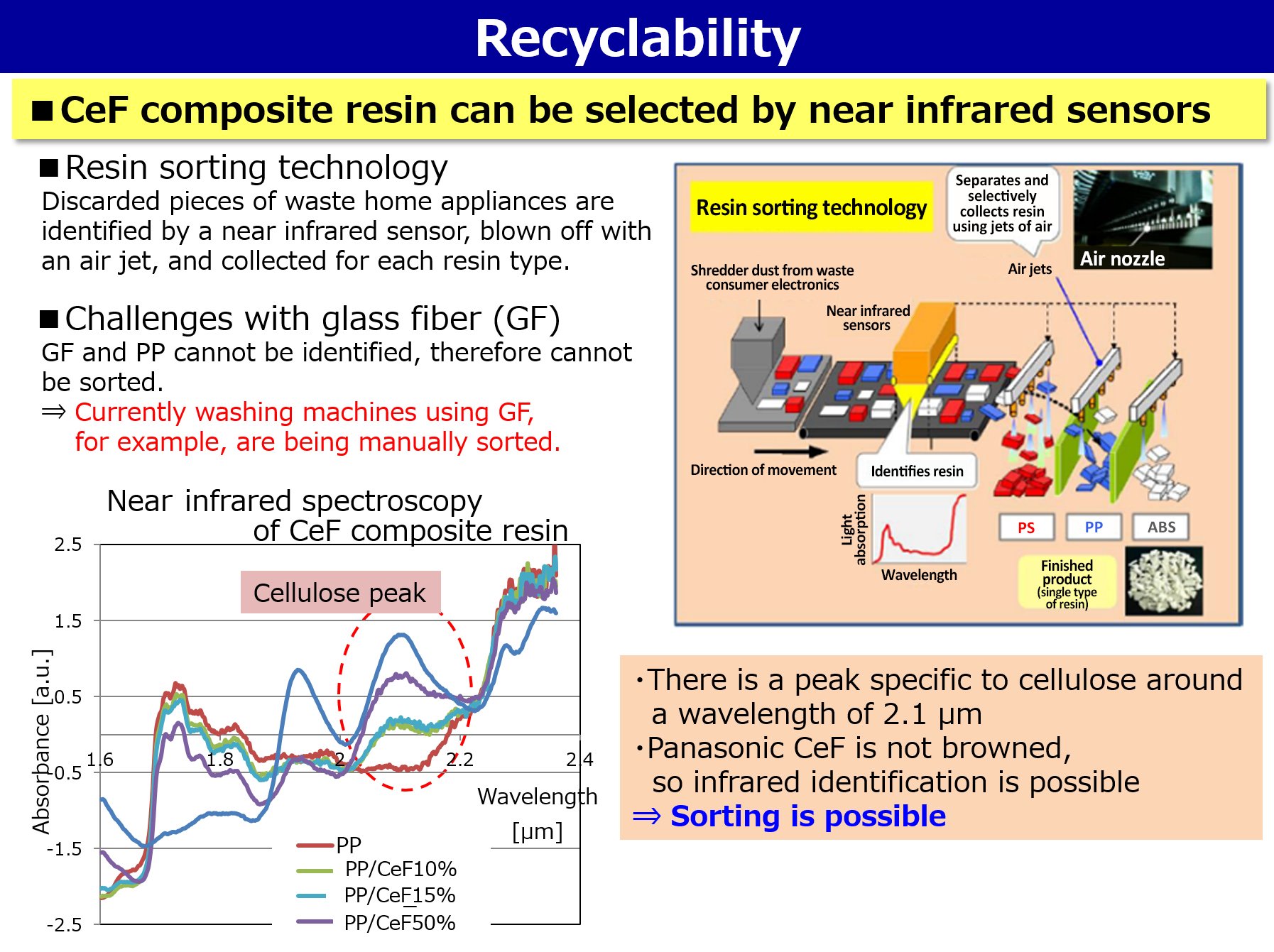
Panasonic has over 300 manufacturing sites around the world. In order to reduce the amount of plastic used at these sites and to contribute to the realization of a circular society, Panasonic has been undertaking research and development of eco-conscious materials that can potentially replace plastics. In 2019, Panasonic introduced a composite processing technology that combines a high concentration of plant-derived cellulose fiber resin. As a molding material that will further promote recycling-oriented manufacturing, it is already being applied to chassis of consumer electronics, reusable cups, etc.
Worldwide, more than 300 million tons of plastic is being consumed every year, and this number is still on the rise. On the other hand, only 14% is being recycled (according to documents published by the United Nations Environment Programme). As we face issues such as plastic waste polluting the sea, declining oil fields, and global warming, there is a global urgency to reduce petroleum-based plastics. In its "Sustainable Development Goals (SDGs), United Nations has also identified "Achieve the efficient use of natural resources" and "Prevent and significantly reduce marine pollution" as important goals.
To answer this call to action, Panasonic began its research and development of eco-conscious materials in 2015. What Panasonic focused its attention on was plant-derived cellulose fiber. This light, but strong eco-conscious biomass molding material is made by extracting fiber from cellulose, a key composite of plants, fibrillating, and mixing it with resin as a reinforcing agent.
Cellulose fiber is made from pulp, which comes from trees, a recyclable natural resource. Pulp can also be created from thinned wood from forests and plant resources including industrial waste. It has drawn attention as a sustainable resource that can be reproduced by strategically planting trees.
"Completely dry process" that no longer requires drying
Generally, cellulose fiber is extracted from pulp by fibrillating the pulp in water. The cellulose fiber must then be dried before it can be mixed with resin, and the energy and cost required to do so had been a challenge in the past. Panasonic developed a proprietary process that is completely dry by fibrillating pulp in molten resin rather than water. By getting rid of the drying process, Panasonic made it possible to manufacture cellulose fiber more efficiently.
The cellulose fiber resin created by applying this completely dry process was used for the chassis of Panasonic's cordless stick vacuum cleaners, MC-SBU820J/MC-SBU620, introduced to the market in August 2018. The cellulose fiber resin used on these products boasted approximately eight times the impact resistance of glass fibers, but in addition to durability, it also successfully reduced the amount of plastic used. Furthermore, with the composite processing technology developed in 2019, Panasonic made it possible to mix cellulose fiber at a high concentration of 55%. Panasonic will continue to make improvements to the material, including the enhancement of its strength and durability.
Ensuring recyclability
Cellulose fiber is also easier to process and recycle. When materials containing glass fiber is burned after use, you still end up with the glass fiber, so it will need to be sent to the landfill or be processed in some other way. Even if you spent it to be recycled, it would not be as durable as before. When you burn composite materials made from cellulose fiber resin, however, because it is plant-based, nothing remains. Moreover, with Panasonic's proprietary, highly accurate near infrared sensor sorting system, materials can be sorted based on each resin type, thus it can be reused as recycled material whilst relatively maintaining durability.
Introduced reusable cups with a high degree of coloring freedom
By employing proprietary kneading (melting, mixing, and homogenizing) technology, when creating the composite Panasonic's cellulose fiber resin is produced as a white molding material. That is why it delivers a high degree of coloring freedom and can bring to life a unique wood texture, scent, etc. in line with the characteristics of the plant material.
In August 2019, with Asahi Breweries, Ltd. Panasonic launched reusable cups made from high concentration cellulose fiber molding material. These reusable cups are being tested in the field so that they may be used for outdoor events or for takeout.
In 2017, Panasonic formulated the "Panasonic Environment Vision 2050," and with 2050 in sight, it will continue to reduce the energy consumption and aspire to produce energy that surpasses consumption. Panasonic will also continue to promote the use of its cellulose fiber molding material and to develop new eco-conscious materials so that it may contribute to "a sustainable society through its business activities."
Cellulose fiber molding material development team (Photo center: Panasonic Corporation Manufacturing Innovation Division, General Manager, Hideo Ohara. Photo left: Same division, Production Engineering and Green Technology Laboratory, Chief Engineer, Toshifumi Nagino. Photo right: Same division, Mold & Die Technology Center, Manager, Tsuyoshi Kiritohshi)
To develop cellulose fiber molding material, Panasonic utilized the findings from the following projects consigned by the Ministry of the Environment.
1. FY2015-FY2017, Development of technology to reduce CO2 emissions during the cellulose nano fiber production process.
2. FY2016-FY2017, Performance evaluation of consumer electronics utilizing cellulose nano fiber and testing its implementation.
3. FY2017-FY2019, Performance evaluation of cellulose nanofiber recycling, etc.
# # #
- Disclaimer:
- We would like to note that Panasonic Newsroom is not a place to address personal Customer Service issues. Even though this is not the forum, Panasonic is always eager to resolve your concerns. Our local customer services contacts can be found at Global Support or you can see our list of Social Media Accounts to find the right channel for your queries and concerns.



















